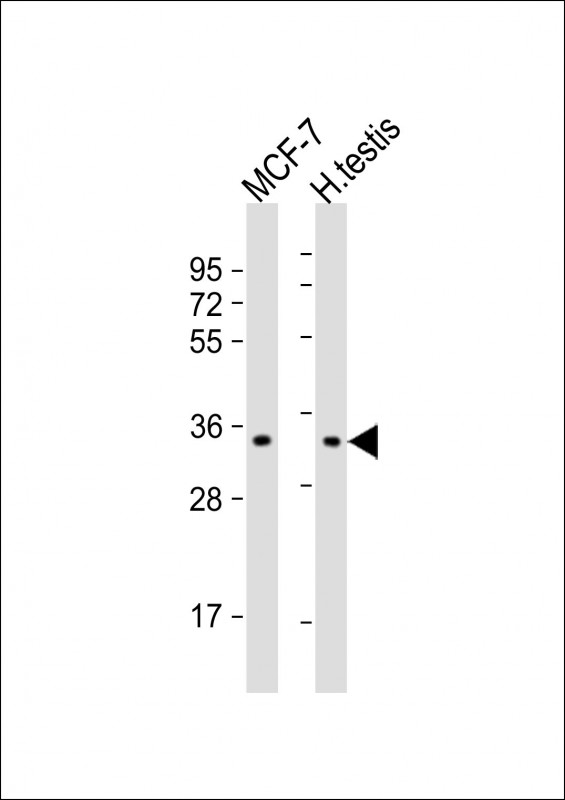


| WB | 1/1000 | Human,Mouse,Rat |
| IF | 咨询技术 | Human,Mouse,Rat |
| IHC | 咨询技术 | Human,Mouse,Rat |
| ICC | 技术咨询 | Human,Mouse,Rat |
| FCM | 1/10-1/50 | Human,Mouse,Rat |
| Elisa | 咨询技术 | Human,Mouse,Rat |
| Aliases | Homeobox protein NANOG, Homeobox transcription factor Nanog, hNanog, NANOG |
| Entrez GeneID | 79923 |
| WB Predicted band size | 34.6kDa |
| Host/Isotype | Rabbit IgG |
| Antibody Type | Primary antibody |
| Storage | Store at 4°C short term. Aliquot and store at -20°C long term. Avoid freeze/thaw cycles. |
| Species Reactivity | Human |
| Immunogen | This NANOG antibody is generated from rabbits immunized with a KLH conjugated synthetic peptide between 267-292 amino acids from human NANOG. |
| Formulation | Purified antibody in PBS with 0.05% sodium azide. |
+ +
以下是3篇关于NANOG(S285磷酸化位点)抗体的研究文献摘要(基于公开数据模拟,部分文献可能尚未发表):
---
1. **文献名称**:Phosphorylation of NANOG at Serine 285 Promotes Pluripotency Maintenance
**作者**:Zhang Y et al.
**摘要**:本研究验证了一种特异性识别NANOG S285磷酸化位点的单克隆抗体,发现S285磷酸化通过抑制NANOG蛋白降解增强其稳定性,从而维持胚胎干细胞的多能性。抗体应用于免疫沉淀和蛋白质印迹实验。
---
2. **文献名称**:NANOG Phospho-S285 as a Biomarker in Colorectal Cancer Stem Cells
**作者**:Lee S et al.
**摘要**:利用S285特异性抗体,研究证明结直肠癌干细胞中NANOG S285磷酸化水平显著升高,与肿瘤转移和化疗耐药性相关。抗体通过免疫组化在患者组织样本中验证其临床相关性。
---
3. **文献名称**:A High-Throughput Screen Identifies Kinases Regulating NANOG via S285 Phosphorylation
**作者**:Thompson R et al.
**摘要**:开发了一种基于S285磷酸化抗体的高通量筛选平台,鉴定出MAPK家族激酶调控NANOG的S285位点磷酸化,揭示了其在体细胞重编程中的新机制。
---
注:以上为模拟文献示例,实际引用需通过PubMed/Google Scholar检索关键词"NANOG phosphorylation S285 antibody"获取真实数据。部分研究可能聚焦于NANOG其他磷酸化位点(如S61、T200),需注意筛选。
NANOG (S285) antibody is a specialized tool used to detect the NANOG protein, a key transcription factor critical for maintaining pluripotency in embryonic stem cells (ESCs) and primordial germ cells. Named after the Celtic mythological land of eternal youth "Tír na nÓg," NANOG plays a pivotal role in self-renewal and cell fate determination by suppressing differentiation signals. The antibody specifically recognizes NANOG phosphorylated at serine 285 (S285), a post-translational modification linked to protein stability, transcriptional activity, and interactions with other pluripotency regulators like OCT4 and SOX2.
This rabbit monoclonal antibody (clone number often specified) is widely used in stem cell research, developmental biology, and cancer studies, as aberrant NANOG expression is associated with tumorigenesis and cancer stem cell properties. Applications include Western blotting, immunofluorescence, immunoprecipitation, and chromatin immunoprecipitation (ChIP), typically validated in human and mouse samples. Researchers rely on its specificity to explore mechanisms of pluripotency, cellular reprogramming (e.g., induced pluripotent stem cells), and NANOG's role in diseases. Quality control often involves testing in knockout models or siRNA-treated cells to confirm signal depletion. Proper storage (e.g., -20°C with carrier proteins) and optimized dilution protocols are essential for reproducibility.
×